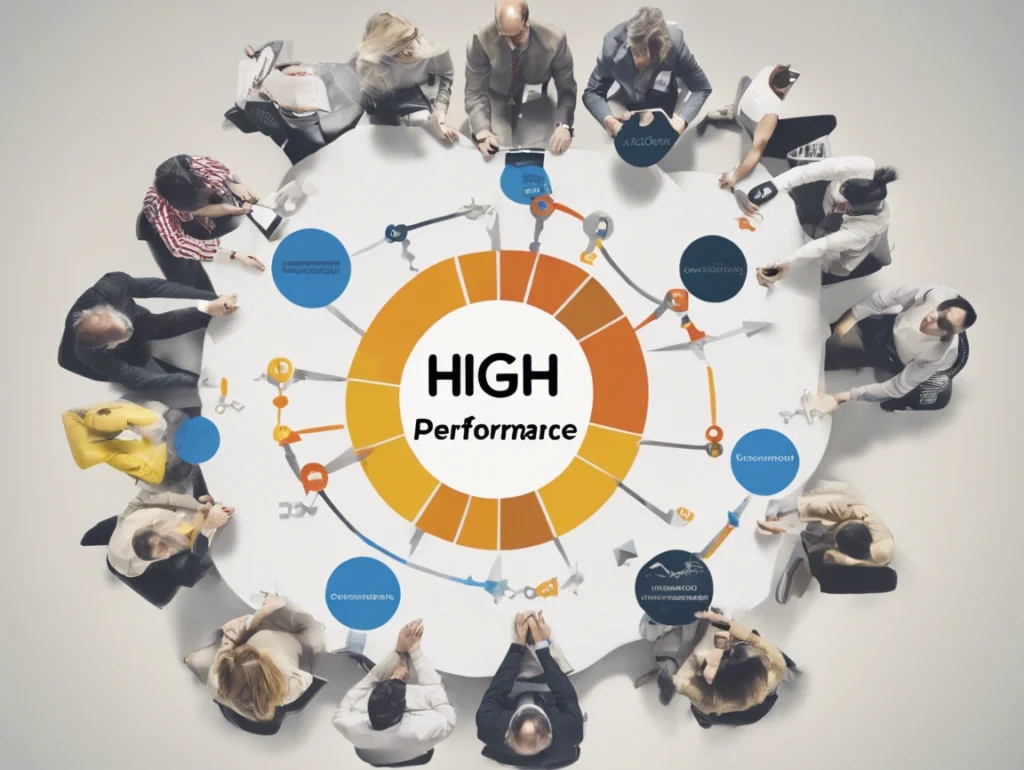Building a High-Performance Organizational Culture: Strategies and Measurement

Understanding High-Performance Culture
A high-performance organizational culture is a dynamic framework where innovation, accountability, collaboration, and continuous improvement serve as the bedrock of day-to-day operations. Underpinning this framework is a shared vision and set of values that guide the behaviors, mindsets, and decision-making processes of all employees within the organization. This culture not only drives excellence but also fosters a unified direction, enabling the organization to adapt and thrive in an ever-evolving market environment.
Key characteristics of a high-performance culture include the pursuit of innovation, where employees are empowered and encouraged to think creatively, challenge the status quo, and develop novel solutions. Accountability ensures that every team member takes ownership of their responsibilities and contributes to the organization’s overarching objectives. Collaboration is essential, as it fosters a collective drive towards shared goals, leveraging diverse perspectives for the common good. Lastly, a commitment to continuous improvement ensures that the organization is always looking for ways to optimize processes, enhance skills, and achieve higher levels of performance.
Adopting these attributes, companies like Google, Netflix, and Toyota exemplify what high-performance cultures look like in action. Google’s environment of innovation is supported by its famed ‘20% time’ policy, which allows employees to dedicate a portion of their work hours to projects they are passionate about. This has been a source of numerous groundbreaking products. Netflix empowers its employees with freedom and responsibility, fostering accountability and driving outstanding content creation. Toyota’s approach to continuous improvement, often termed ‘Kaizen,’ is a testament to its relentless focus on operational excellence and quality.
The importance of a shared vision and values cannot be overstated. They act as a guiding compass, ensuring all employees are aligned with the organization’s mission and goals. This alignment not only motivates but also creates a cohesive and resilient workforce capable of navigating challenges and seizing opportunities with agility and precision. In conclusion, cultivating a high-performance culture is essential for organizations aiming to achieve sustained success and competitive advantage in today’s fast-paced business landscape.
Strategies to Build a High-Performance Culture
Developing a high-performance culture within an organization requires deliberate strategies that focus on various critical aspects. Central to this process is leadership commitment, as leaders set the precedent for organizational behavior and expectations. Leadership must visibly prioritize high performance and consistently communicate its importance to the team. Effective communication, therefore, becomes pivotal in ensuring that every member understands and aligns with the organization’s goals.
Clear goals and expectations form the foundation of a smooth and high-performing organizational culture. Goals should be specific, measurable, achievable, relevant, and time-bound (SMART), providing employees with a clear roadmap. Establishing these goals should be a collaborative process, ensuring buy-in from all team members. Regularly revisiting and adjusting these goals as the organization evolves also keeps the team focused and motivated.
Employee engagement and empowerment are equally significant in cultivating a high-performance culture. Implementing robust feedback systems is a practical step in this direction. These systems should facilitate continuous two-way communication, allowing employees to voice their opinions and receive constructive feedback. Platforms for regular check-ins and performance reviews can help keep employees aligned and clear about expectations.
Fostering professional development opportunities is another crucial strategy. Organizations should offer training programs, workshops, and career advancement opportunities that align with both the employee’s personal growth and the organization’s needs. Recognizing and rewarding achievements through formal programs or public acknowledgment boosts morale, reinforces desired behaviors, and drives performance.
Additionally, the workplace environment and practices must support the desired culture. This involves creating a physical and psychological environment conducive to high performance, including ergonomic spaces, mental health support, and a culture of trust and transparency. Aligning workplace policies with cultural goals ensures consistency and aids in embedding the high-performance ethic within every aspect of the organizational operations.
Examples of Successful High-Performance Cultures
In examining organizations that have successfully cultivated high-performance cultures, several companies stand out as exemplary models. Among these, Google, Zappos, and Southwest Airlines each showcase unique strategies and initiatives that contribute to their outstanding organizational environments and performance.
Google is renowned for its emphasis on innovation and autonomy. By fostering an environment where employees are encouraged to experiment and think creatively, Google maintains a pioneering stance in technological development. The company’s “20% time” policy, which allows employees to spend 20% of their time working on projects outside their primary responsibilities, serves as a prime example of promoting autonomy and trust. This initiative has led to the creation of several successful products, including Gmail and Google News, demonstrating the tangible benefits of an innovative culture.
In contrast, Zappos focuses heavily on customer service and employee satisfaction. The company’s culture is built around a set of ten core values, with an unwavering commitment to customer happiness being paramount. Zappos invests in extensive training and development programs, ensuring employees are well-equipped to deliver exceptional service. Moreover, the company has a rigorous hiring process to ensure cultural fit, emphasizing the importance of hiring individuals who align with its core values. The results of these efforts are evident in Zappos’ consistently high customer satisfaction ratings and low employee turnover rates, underscoring the effectiveness of a culture centered around people.
Southwest Airlines exemplifies a culture of employee empowerment and teamwork. Known for its exceptional labor relations, Southwest’s culture emphasizes the importance of treating employees well, which in turn leads to superior customer service. The company empowers its staff to make decisions and encourages a collaborative work environment. This high-trust culture not only boosts employee morale but also enhances operational efficiency. Southwest’s success in maintaining low operational costs and achieving consistent profitability in the highly competitive airline industry highlights the competitive advantages of a strong, cohesive organizational culture.
These examples illustrate that there is no one-size-fits-all approach to building a high-performance culture. However, the common thread across Google, Zappos, and Southwest Airlines is a deliberate, strategic emphasis on fostering an environment that supports and values employees, ultimately driving superior organizational performance.
Measuring Organizational Culture
To build a high-performance organizational culture, it is crucial to assess and measure its effectiveness continuously. Integrating both qualitative and quantitative tools into the evaluation process offers a comprehensive view. Employee surveys, focus groups, and performance metrics are commonly employed to gather valuable insights.
Employee surveys provide useful data on various facets of the organizational culture. They can encompass questions about job satisfaction, levels of engagement, perceptions of management, and alignment with core values. For instance, surveys like Gallup’s Q12 or the Denison Culture Model can yield actionable insights. Likewise, focus groups serve as qualitative tools that facilitate in-depth discussions on specific cultural elements within the organization, allowing for nuanced feedback and richer context.
Key indicators such as employee satisfaction and retention rates are critical in measuring organizational culture. High satisfaction often correlates with a positive culture, while low turnover rates can indicate strong alignment with organizational values. Productivity levels are another vital metric; increased efficiency and output often reflect a conducive working environment. Additionally, alignment with core values plays a significant role, as it highlights how well the workforce embodies the principles that the organization stands for.
Furthermore, performance metrics such as project completion rates and customer satisfaction scores can indirectly reveal cultural strengths or weaknesses. Analyzing these alongside direct feedback mechanisms enables organizations to spot trends and areas for improvement.
Prominent frameworks and assessment tools, including the Denison Culture Model and the Organizational Culture Assessment Instrument (OCAI), offer structured methodologies to evaluate organizational culture. These frameworks provide benchmarks and guidelines that help organizations pinpoint specific areas needing attention.
By leveraging these measurements, organizations can make informed decisions to drive continuous improvements. Regularly assessing the cultural landscape ensures that strategic initiatives remain aligned with the overall goals, fostering a high-performance organizational culture that is resilient and adaptive.






Responses